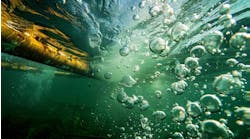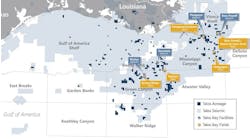Offshore staff
(Houston)- Chris Oynes, MMS director for the GoM region, believes that the 2005 hurricane season was not a one-time event, and in fact the upcoming season may provide the GoM E&P community with continuing challenges. Oynes addressed a large group of energy industry professionals at a luncheon in Houston recently.
Oynes updated the audience on where the GoM offshore production sector currently stands on hurricane damage and how repairs to the infrastructure are proceeding. He also discussed new developments for the region, in terms of both legislation and exploration.
Oynes reiterated the sobering statistics of lost production and platforms in the region as a consequence of Katrina and Rita. Total shut-in production to date as a result of these two storms is currently estimated at 133 MMbbl of oil and 580 Bcf of gas. As of the end of December, 26% of oil production and 20% of gas production remained shut in. When asked about lost reserves, Oynes was optimistic, estimating that only 1-3% of reserves would be lost, but this number may decrease as more production is brought back on stream.
Of major concern to Oynes was the number of younger production facilities that were lost. Of the 113 platforms that are currently known to be destroyed, 22 of them were less than 10 years old. These were built to the newer standards for structural integrity and deck height. This fact has prompted MMS to sponsor a research initiative program to understand damage as a consequence of pipeline movement, damage to platforms, and a hindcast of wave and wind's effects on the structural integrity of platforms and pipelines. The major focus of these studies will be to help the industry arrive at better standards for structural requirements and deck height.
Looking forward to 2006 and beyond, Oynes sees several positive developments for the E&P community. He pointed to the added incentives that were introduced in 2005 for development in the GoM, most importantly the three tiers of royalty incentive relief for deep gas development in 200-400 m of water. These incentives are scheduled to show up in the March 2006 lease sales.
The most important trend in Oynes' opinion is the growing list of discoveries in ultra deepwater (5,000 ft and deeper). Over 80% of the discoveries made in the GoM in the past two years classify as ultra deepwater finds. While a significant amount of testing is underway to determine the true potential of some of these finds, Oynes highlighted the Independence Hub project as one of the major going-forward developments. When production starts in 2007, initial estimates for Independence Hub are 850 MMcf/d of gas from 8 discoveries tied back to a central production hub. Production is expected to grow to 1 Bcf/d once two additional fields are tied in.
While these comments were well-received by the audience at large, there were still a number of questions around ensuring structural integrity of the production infrastructure for future hurricane seasons. Oynes answered that MMS will not take the lead on setting requirements for structural improvements, but will instead take its cue from the industry itself. The industry is already taking steps to improve platform integrity, Oynes pointed out, such as the move to a 12-point mooring system as opposed to a 9-point mooring system.
01/11/2006


